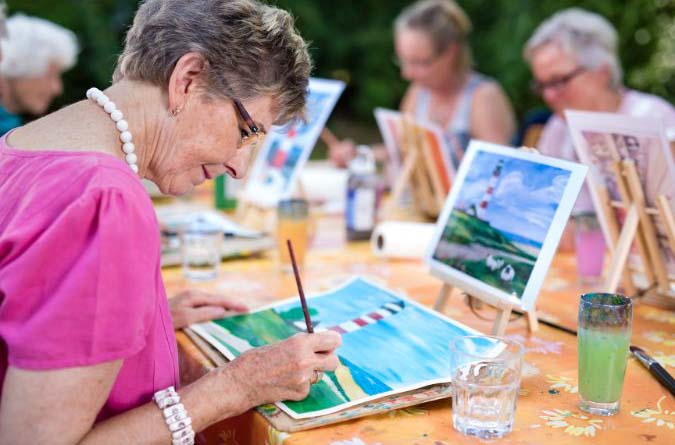To help individuals who are suffering from mental illness and emotional disorders, a psychologist or counselor will recommend one or several types of psychotherapy that may suit them. However, not all mental health conditions will respond well to certain types of psychological treatments; some may require other types of therapies.
Art therapy is one of the psychotherapy forms that psychologists use to help individuals overcome their emotional problems, which may be confusing to them, through art and creativity. Created by British artist Adrian Hill in 1942, art therapy has become one of the most effective psychotherapies until the present.

Okay, here’s everything you can know about art therapy!
Definition of Art Therapy
Basically, art therapy takes advantage of creative processes—such as painting, drawing, sculpting, and other art forms—to facilitate someone’s psychological healing. This is a form of expressive therapy that combines traditional therapeutic methods with the expressive nature of art to help people explore their emotions, improve their overall well-being, and enhance their cognitive abilities with new pathways to self-understanding and expression.
Additionally, art therapy is used to encourage individuals to express and understand their emotions, making it easier for them to solve their problems. So, they can manage their behavior and feelings, reduce stress, and increase self-esteem and awareness.
Art therapy definitely involves the creation of art, which is based on psychology, human development, personality theories, family systems, and art education. This form of psychotherapy is also possible to incorporate into one-on-one sessions, family or couples therapy, and group therapy.
Focus of Art Therapy
Unlike art classes that aim to learn and create works of art, art therapy focuses on the process of creation and the insights obtained from it—the artwork created in art therapy is not the main goal. Instead, it serves as a visual representation of the individual’s feelings, thoughts, and experiences.
One of the main differences between art therapy and other forms of therapy is that most treatments use words or language as a means of communication. Meanwhile, art therapy uses art tools and materials as a medium to express emotions and feelings.
Through art-making processes, the person who undergoes art therapy will feel more in control over their life, so they will enjoy every single process they do. Furthermore, they may gain insights into their emotions, develop problem-solving skills, and find new ways of coping with challenges.
Even though the main focus of art therapy and class therapy is different, what they do in art therapy exercises will be the same, such as:
- Drawing
- Finger painting
- Painting
- Sculpting
- Carving
- Working with clay
- Making collages
- Doodling and scribbling
To understand what they are feeling, a psychologist or therapist will then discuss the artwork by exploring what objects, people, and images they draw or don’t draw in it. After knowing their emotions and responses, the psychologists will find it easier to guide and carry out therapy in accordance with their problems—problem solving to overcome their problems can be easily achieved.
One of the main differences between art therapy and other forms of therapy is that most treatments use words or language as a means of communication. Meanwhile, art therapy uses art tools and materials as a medium to express emotions and feelings.
Who Can Conduct and Use Art Therapy
Since art therapy serves as a psychological treatment, of course, those who can conduct art therapy are those who are experts in psychology, such as psychologists, trained art therapists, counselors, and other licensed professionals who can perform both therapy and art.
Basically, it is not just people who need mental health treatment—anyone can really use art therapy to communicate and express themselves. To undergo art therapy, someone does not have to be talented in art or even become a good artist. This form of therapy is more than an art class or just something to keep people occupied.
However, there will be professionals who can work with you and guide you through artistic activity and encourage you to use artistic materials and methods as a means of self-expression. Even though art therapy can do different things for different people, it will work for healing, treatment, and rehabilitation. And in a broad sense, it can be used to massage someone’s inner being in a way that can give them a deeper understanding of themselves.
Where Art Therapy Can Be Conducted
Art therapy can be performed in various places, such as hospitals, mental health clinics, rehabilitation centers, schools, and community programs. Usually, people who want to undergo art therapy will visit an experienced psychologist. whereas art therapy can also be conducted by professionals who have undergone specialized training in both art and psychology therapy.
The places that provide art therapy must have a supportive and non-judgmental environment for every individual to uncover their emotions and work towards personal healing and growth. Sometimes, many people find it hard to express themselves and will need a medium to facilitate their feelings.
Things That May Exist in Art Therapy
In addition to the presence of a psychologist or trained professional, there are several other things that may be present during an art therapy session. The items that will be needed for art therapy must exist, such as art materials, tools, and visual artwork. These could be:
- Paints
- Chalk
- Markers
- Drawing sheets
- Canvas
- Slime
- Clay
- Acrylic paint
- Watercolour
- Jewelry-making kits
- Painting
- Photography
- Sculpture or a variety of other types of visual art expression
- Many more
Advantages of Art Therapy
Art therapy is very helpful and beneficial for people of all ages in addressing anxiety, trauma, grief, depression, stress, and relationship difficulties. It serves as a therapeutic approach for individuals who are dealing with various emotional, behavioral, or mental illnesses.
Just like other expressive art therapies such as music therapy or dance therapy, art theory also encourages individuals to explore their creativity. With the use of art tools and materials, it can really help individuals interpret, express, and overcome their thoughts and emotions.
Art therapy also aims to improve someone’s well-being and bring back his or her function. In turn, it can really enhance personal development and coping skills, as well as improve cognitive function. The point is that one of the advantages of art as therapy is the ability to express someone’s feelings through any form of art.

A bookworm and researcher especially related to law and citizenship education. I spend time every day in front of the internet and the campus library.





